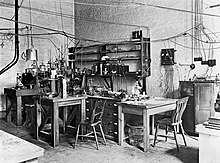Esther Salaman
Esther Salaman | |
|---|---|
| Born | Esther Polianowsky 6 January 1900 Cambridge University (1925–28) |
| Spouse |
Myer Salaman
(m. 1924; died 1994) |
Esther "Polly" Salaman (née Polianowsky) (Hebrew: אֶסְתֵּר פאָליאַנאָווסקי שָׂלָמָן, Russian: Эстер Поляновская Саламан; 6 January 1900 – 9 November 1995) was a
Biography
Early life
Esther Polianowsky was born in
Polianowsky fought in the Ukrainian national resistance during the Russian Civil War, thereupon escaping to Mandatory Palestine in January 1920 to join a group of pioneer agricultural workers.[2] She succeeded in securing travel documents for her widowed mother and four siblings, and paid a team of Polish foresters to lead them to the Polish border in secret. From there, Esther guided them to Palestine.[3]
Education

Despite the volatile situation for Jews in
As the
Early career
At the suggestion of Ludwig Wittgenstein, Esther began writing fiction for an English audience.[5] She published her first novel, Two Silver Roubles, in 1932, only six years after arriving in England knowing only Yiddish, Russian, German, and Hebrew.[7]
From 1940, Myer and Esther Salaman shared a large home in Cambridge with their close friends
The two families often retreated to
Salaman's reminiscences of Einstein were broadcast on the BBC Third Programme in 1955, and her second novel, The Fertile Plain, was published in 1956.[6][12]
Later life
In 1948, Myer Salaman was hired as Director of the Cancer Research Department at the London Hospital Medical College and the family moved to London.[6] Esther Salaman's later works include A Collection of Moments (1970), a study of involuntary memory, and The Great Confession (1973), which explores the use of memory by Aksakov, De Quincey, Tolstoy and Proust. She published memoirs of Albert Einstein and Paul Dirac in Encounter in 1979 and 1986 respectively.
She died on 9 November 1995 at the age of 95.
Bibliography
- Salaman, Esther (1932). Two Silver Roubles. London: Macmillan.
- Cornford, Frances; Salaman, E. Polianowsky (1943). Poems from the Russian. London: Faber and Faber.
- Salaman, Esther (1956). The Fertile Plain. London: The Hogarth Press.
- Salaman, Esther (1970). A Collection of Moments: A Study of Involuntary Memories. New York: St. Martin's Press.
- Salaman, Esther (1973). The Great Confession: From Aksakov and De Quincey to Tolstoy and Proust. London: The Penguin Press. ISBN 9780713904598.
References
- ^ ISSN 1209-9392.
- ^ a b Polak, Dolf (23 November 1995). "Obituary: Esther Salaman". The Independent. Retrieved 30 May 2019.
- ^ Wordsworth, Saul (July 2009). "My Russian Grandmother". SaulWordsworth.com. Archived from the original on 6 June 2019.
- ^ a b Salaman, Esther (April 1979). "Memories of Einstein". Encounter. 52 (4): 19–23.
- ^ ISSN 1209-9392.
- ^ a b c d Salaman, Esther; Salaman, Myer (May 1986). "Remembering Paul Dirac". Encounter. 66 (5): 66–70.
- ISBN 978-0-7735-4176-4.
- ^ Falk, James Edward. "Family Card". Retrieved 4 November 2022.
- OCLC 967739488.
- ISBN 978-3-16-153207-8.
- ^ "Ringstead Towermill". Norfolk Mills. Archived from the original on 13 June 2019. Retrieved 13 June 2019.
- ^ Jacobson, Dan (December 1956). "Memory Uncorrupted". Commentary.
